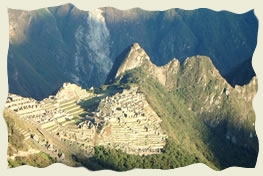The Inca had no written language, but they still recorded many details about their life. They kept track of gold, land, crops, and other things by using knotted strings. The length and color of the strings, and the spacing of the knots, all had meaning. Specially trained people could “read” the strings.
WHAT WAS THE INCA EMPIRE?
The Inca Empire was a vast kingdom in the Andes Mountains of South America. Inca emperors controlled a huge area and ruled millions of people. It was the largest civilization in South America before the arrival of Europeans.
According to Inca legend, the Inca first lived near Lake Titicaca in southeastern Peru. The legend says the first Inca emperor, Manco Capac, led the Inca north to the fertile valley of Cuzco. They arrived in Cuzco (in southern Peru) about ad 1200 and conquered the people there. Cuzco became the Inca’s capital city.
Over time, the Inca conquered many neighboring groups. The Inca Empire grew large and rich. Centered in Peru, the empire extended over high mountains, grassy plateaus, fertile valleys, jungles, and coastal land. It covered parts of what are now Ecuador, Bolivia, Chile, and Argentina.
REMARKABLE BUILDINGS
The Inca constructed impressive buildings out of stone. The Inca did not use the wheel. So to move large boulders, they used wooden rollers and ramps made of dirt. They shaped the boulders into blocks with axes and smoothed them with sand and water. Then they stacked the blocks to make walls, arches, and other structures.
The Inca shaped their building blocks with great accuracy. The blocks fit together so tightly that a knife will not fit between them! For this reason, they didn’t need to use mortar (a binding material put between blocks or bricks).
The Inca built many large temples, palaces, plazas, and forts. Cuzco itself was a marvel of Inca engineering. Gold plating nearly covered Cuzco’s great Temple of the Sun. In the temple’s courtyard, gold carvings showed scenes from Inca life. Gold corn appeared to grow out of golden soil. Golden llamas grazed on golden grass.
Another spectacular Inca city was Machu Picchu. It was built on a ridge high in the Andes, above Cuzco. The ruins of the city were discovered in 1911.
ROADS, BRIDGES, AND TERRACES
To rule their large kingdom, Inca emperors built a network of stone roads that extended 10,000 miles (16,000 kilometers). Working in relays, runners used these roads to carry messages up to 250 miles (400 kilometers) in a single day. Government officials could travel the roads to every village in the empire.
To span the deep river gorges in the mountains, the Inca built rope bridges. The bridges were amazingly durable. One rope bridge over a dangerous ravine was used for more than 500 years!
The mountains posed a challenge for farming. The Inca built stone walls in steep valleys to create level fields, called terraces. These terraces extend up the sides of mountains like giant staircases. In some areas, the Inca built canals to bring water to the terraces.
LIFE AS AN INCA
Inca society was strictly organized. The emperor and his royal family were at the top of Inca society. The Inca believed the emperor was descended from the Sun god, Inti.
Below the emperor came the nobility. These Inca were related to the emperor. They held the most important positions in the government, the military, and in religious life. Peasants who farmed the land were at the bottom of Inca society.
The Inca worshiped the creator god, Viracocha, the Sun god, Inti, and other lesser gods. The bodies of dead rulers were kept in shrines. Dead rulers had servants and were consulted on daily affairs—as if they were still alive.
Priests were important in Inca life. In sacred rituals, priests often sacrificed llamas or guinea pigs to the gods. Sometimes they sacrificed children or women.
ARTS AND CRAFTS
Inca craft workers used copper and bronze to make tools and ornaments. They used gold and silver for jewelry and for everyday objects such as nails, combs, and dishes for the nobility. Goldsmiths were so respected that they lived in a special neighborhood and paid no taxes.
The finest Inca art has not survived. Spanish conquerors melted down these objects and shipped the gold back to Spain.
The Inca had extensive knowledge of plants for food and medicine. They developed many of the plants we eat today. These include types of corn, potatoes, tomatoes, squash, beans, and peppers. To the Inca, pepper plants were sacred. In fact, peppers were so valuable they could be used as money.
CONQUERED BY THE SPANISH
Inca civilization was most powerful in the late 1400s. In 1532, the Spanish explorer Francisco Pizarro and 180 Spanish soldiers landed on the coast of Peru.
At first, the Inca believed Pizarro was their god, Viracocha. Pizarro and his men seized the Inca emperor. To save his own life, the emperor offered Pizarro enough gold to fill a room. But the Spaniards killed the emperor and took over the Inca Empire.
The Spanish conquerors looted Inca treasures and made the Inca into slaves. Many Inca died from mistreatment and from European diseases. Other Inca fled.
Today, about 8 million descendants of the Inca live in the lands of the former Inca Empire. Many still speak Quechuan, the ancient Inca language. They still follow many Inca beliefs and customs.





0 comments:
Posting Komentar
komentar anda mengandung ribuan arti buat saya maka dari itu kritik dan sarannya ditunggu lewat komentar disini yaaaa.....
Rekor komentar : 15 komentar....tambahin yaaa hehe